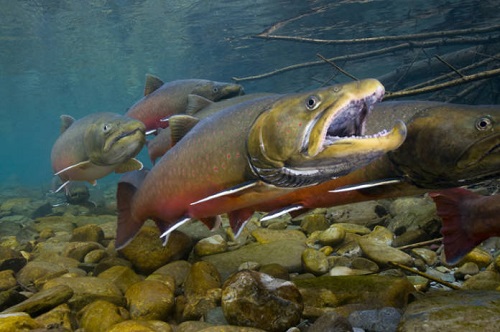 Efforts to conserve a key cold-water fish species got a boost today when the U.S. Fish and Wildlife Service (Service) released the final Bull Trout Recovery Plan, which outlines the conservation actions needed to recover bull trout (Salvelinus confluentus). Bull trout occupy cold-water stream and lake habitats in western North America.
Efforts to conserve a key cold-water fish species got a boost today when the U.S. Fish and Wildlife Service (Service) released the final Bull Trout Recovery Plan, which outlines the conservation actions needed to recover bull trout (Salvelinus confluentus). Bull trout occupy cold-water stream and lake habitats in western North America.

Once abundant in Oregon, Washington, California, Nevada, Idaho and Montana, bull trout are listed as threatened under the Endangered Species Act in the lower 48 states.
The final recovery plan was developed after more than a year of collaboration with interested and knowledgeable federal, tribal, state, private, and other parties. At the core of the plan’s strategy are six geographically specific implementation plans, which identify specific conservation actions needed to address threats such as loss of habitat connectivity and passage barriers, non-native fish competition and predation, and the effects of poor land-management practices.
“The final recovery plan is a conservation compass to guide the recovery of bull trout, especially in places where the threatened fish has the best chance to persist for years to come. The focus is now on the threats to bull trout at the local scale and how we can abate them to stabilize or increase populations,” said Mike Carrier, state supervisor for the Service’s Idaho Fish and Wildlife Office. The Idaho office led the Service’s five-state planning effort.
The overarching goal of the recovery plan is to conserve bull trout so that the fish are geographically widespread with stable populations in each of the six recovery units. Accordingly, the plan’s recovery criteria focus on effective management of known threats to bull trout. The Coastal, Columbia Headwaters, Klamath, Mid-Columbia, Saint Mary and Upper Snake are the six designated recovery units that are home to the threatened population in the lower 48 states.
Bull trout were listed under the Endangered Species Act in 1999. Recovery plan drafts were completed, but never finalized in 2002 and 2004. However, those draft recovery plans helped guide past recovery efforts and laid the foundation for the final plan adopted today.
To view the recovery plan, including the six Recovery Unit Implementation Plans, and learn more about bull trout conservation, visit: http://www.fws.gov/pacific/bulltrout/.
The mission of the U.S. Fish and Wildlife Service is working with others to conserve, protect, and enhance fish, wildlife, plants, and their habitats for the continuing benefit of the American people. We are both a leader and trusted partner in fish and wildlife conservation, known for our scientific excellence, stewardship of lands and natural resources, dedicated professionals, and commitment to public service.
